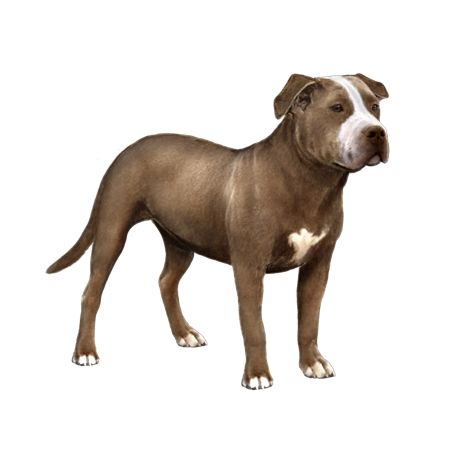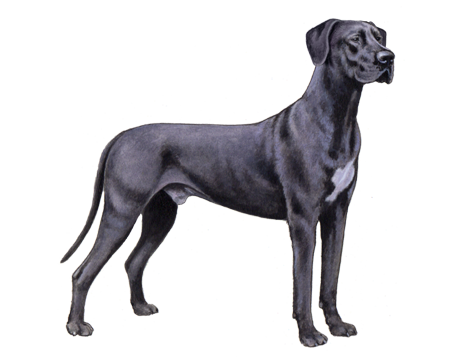
American Pit Bull Terrier
American Pit Bull Terriers are courageous, athletic dogs known for their loyalty and love of children. These eager-to-please pups have an enthusiastic, friendly nature and—when well-trained and socialized—make a great addition to many families.
Interested in discovering if your dog is an American Pit Bull Terrier?
Check out Wisdom Panel's DNA tests.

American Pit Bull Terrier Traits
General Appearance
The American Pit Bull Terrier is a medium-sized dog with a large, square head and powerful, athletic build.
Coat and Colouring
APBTs have short, smooth, glossy coats that are relatively stiff to the touch. They come in all colors and patterns except merle.
Distinctive Physical Traits
American Pit Bull Terriers have broad heads shaped like a blunt wedge. Their ears are small-to-medium-sized and sit high on the head, and their eyes are small, placed well apart and deep set.
These dogs have deep chests and strong, firm backs. They carry their relatively short tails low when relaxed, level with their backs when moving, and raised when excited.
American Pit Bull Terrier Temperament
Affectionate, joyful dogs, American Pit Bull Terriers make loyal family companions. They form strong bonds with their people and are loving and protective around children. But such a friendly nature—even towards strangers—often makes them ill-suited as guard dogs.
APBTs are happiest when with their family. They definitely prefer participating in activities and outings to spending long periods at home alone.
These brave, confident pups require early socialization and obedience training to help them develop into predictable, well-mannered adult dogs.


American Pit Bull Terrier History
The American Pit Bull Terrier (APBT) dates back to 19th-century England when dog fanciers sought to create a dog with gameness, athleticism, and courage. They crossed various terriers and bulldogs, and the resulting dogs made their way to the United States in the late 1800s.
Though originally used for dogfighting, these early pit dogs had a gentle, hard-working nature. As a result, the breed quickly gained a loyal following, and farmers began employing the dogs as herders, guardians, hunters, and companions.
The United Kennel Club was the first club to recognize the American Pit Bull Terrier in 1898. (Fun fact: The UKC founder’s own dog was the first to be registered.) And the American Dog Breeders Association accepted the APBT in 1909. APBTs have since appeared in TV shows, advertising, and even propaganda posters for the two World Wars. Today, this popular breed serves as a working dog, therapy dog, and devoted family companion.
The American Kennel Club was reluctant to register a breed once associated with dog fighting, which led to the creation of the related (but distinct) American Staffordshire Terrier, originally called the Staffordshire Terrier, in 1936
American Pit Bull Terrier Care
Nutrition
American Pit Bull Terriers thrive on a high-quality diet that's appropriate for their life stage. During puppyhood, consider feeding your dog a large-breed puppy formula to prevent them from growing too fast. Growing at a moderate pace can help prevent or reduce the severity of painful hip dysplasia later in life.
Remember to monitor the amount of food you give your APBT and reduce portions back if they gain excess weight. And be sure to track calories from treats. Ideally, they should make up no more than 10% of a dog's daily caloric intake.
Grooming
The APBT's short coat is very low-maintenance. Weekly brushing with a soft-bristled brush and an occasional bath are generally all that’s needed to keep it in tip-top condition.
To reduce your dog's chance of ear infections, check their ears regularly and clean them as needed to remove wax build-up and debris. Nail trims should also be part of their grooming routine. If your pup's nails grow too long, they can cause pain and potentially lead to problems running or walking.
Lastly, a good dental care routine will support your dog's overall health. In addition to scheduling professional cleanings, create an at-home dental program that includes regular teeth brushing and veterinarian-recommended dental chews.
Exercise
As athletic dogs, American Pit Bull Terriers need daily exercise to stay happy and healthy. Ideal activities include long walks on a leash, runs (APBTs make excellent jogging buddies), or chasing a ball in the backyard.
These sporty dogs also enjoy agility, flyball, rally, lure coursing, and dock jumping. Another great option for this breed is competitive obedience training. It not only reinforces desired behaviors but also provides your dog with mental exercise.
Training
American Pit Bull Terriers are eager-to-please and relatively easy dogs to train. But they can be a little stubborn. As such, this breed responds best to firm and dedicated training using positive, reward-based methods.

Breed Group
Guard
Dogs of the Guard Group were bred to guard people and property. They are often quick to learn and these intelligent, capable animals make solid companions.

































